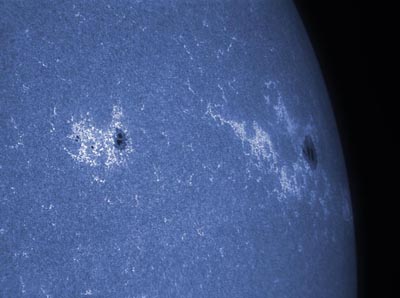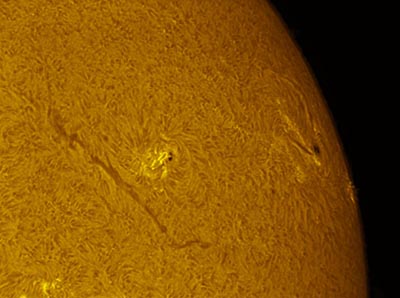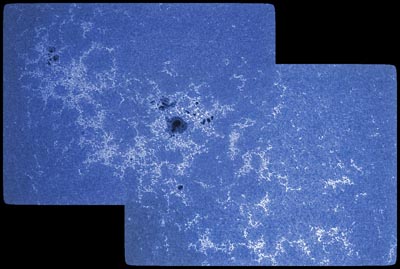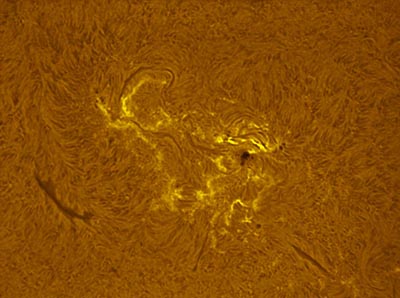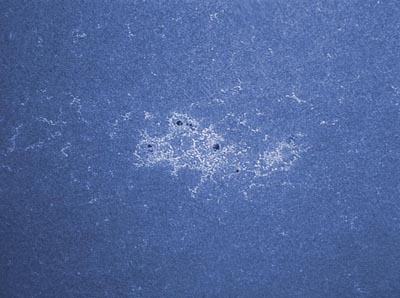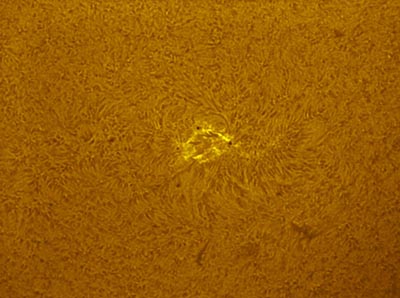Sun in Hydrogen Alpha / CaK
With Coronado 40 / Lunt 60mm CaK
Uploaded 8/18/11

| On
Sunday the seeing was much better, and I took advantage early
before the seeing became worse from the oncoming heat of the
sun rise. This set was taken between 8am and 9am, and is right
now the best seeing time for solar work. These are also some
of the highest resolution Calcium shots so far, the 3x Barlow
kept its sharpness right til 9am. At that point I switched to
the Hydrogen alpha 40mm because it is less affected by seeing
in red wavelengths. |
Click on Images for a larger 1024 x 768 view
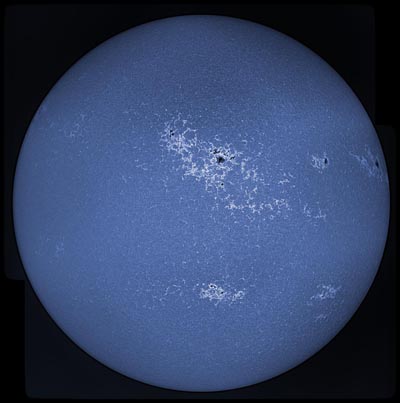 |
Full
disk view with the Lunt 60mm in CaK wavelengths. From two halfs
combined with iMerge. Flats applied for a more uniform disk.
On
the very right edge is our last look at AR1289, which has been
spectacular in producing flares and aurora here on Earth. But
now there is a huge new spot complex just above center on this
image. It is AR1295 and the surrounding group, seen here in a
sea of faculae. Just below center is AR1299, I call the "Shrimp
sunspot" because it looks like two eyes looking back at
you.
|
With 3x Klee Barlow on Both Scopes
Below left: AR1289 moves off the disk, with a smaller spot group following.
Below right: In Halpha light the scale is a bit smaller, but large filament spans this field on the left
Below Left: Two part composite with the Klee showing the full extent and detail of AR1295
Look how nicely iMerge blended the two, and rounded all the corners!
Below Right: Same spot group, but in H alpha light showing minor flaring action all over!
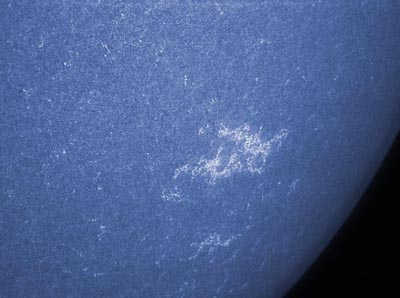 |
AR1294
which is on the lower right corner has very little substance
in the white light realm, but plenty of faculae action around
it. |
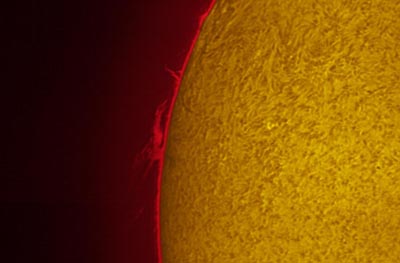 |
On
the oncoming limb, while there were no sunspots or filaments,
a very nice prominence was visible. |
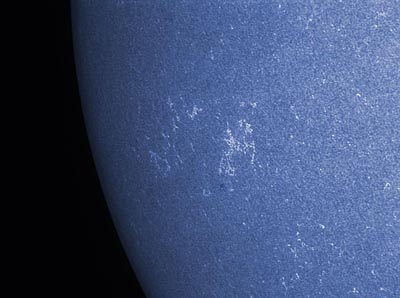 |
This
unnamed region has no spots, but could be the site of a future
outbreak. Here we just see a disturbance in the magnetic fields
as a clump of faculae. |
AR1299 which is just below the center of the disk looks like the eyes of a shrimp in both views.
Lower Left: Calcium shot showing intricate details in the spots and faculae
Lower Right: Halpha view, with low level activity around the spot
|
|
 Instrument: Coronado 40mm Ha or Lunt 60mm CaK
Platform: Astrophysics 1200
Camera: DMK 1024
Location: Payson, Arizona
Elevation: 5150 ft.
Sky: Seeing 8/10, Transparency 8/10
Outside Temperature: 75F
Processing: Registax 6, Photoshop CS2
HOME SCHMIDT GALAXIES EMISSION NEBS REFLECTION NEBS COMETS
GLOBULARS OPEN CLUST PLANETARIES LINKS
Instrument: Coronado 40mm Ha or Lunt 60mm CaK
Platform: Astrophysics 1200
Camera: DMK 1024
Location: Payson, Arizona
Elevation: 5150 ft.
Sky: Seeing 8/10, Transparency 8/10
Outside Temperature: 75F
Processing: Registax 6, Photoshop CS2
HOME SCHMIDT GALAXIES EMISSION NEBS REFLECTION NEBS COMETS
GLOBULARS OPEN CLUST PLANETARIES LINKS
|

Instrument: Coronado 40mm Ha or Lunt 60mm CaK Platform: Astrophysics 1200 Camera: DMK 1024 Location: Payson, Arizona Elevation: 5150 ft. Sky: Seeing 8/10, Transparency 8/10 Outside Temperature: 75F Processing: Registax 6, Photoshop CS2 HOME SCHMIDT GALAXIES EMISSION NEBS REFLECTION NEBS COMETS GLOBULARS OPEN CLUST PLANETARIES LINKS

